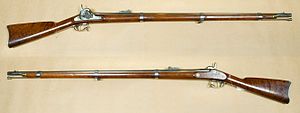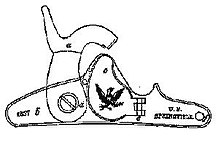
Back Springfield Modelo 1855 Spanish Fusil Springfield Modèle 1855 French スプリングフィールドM1855 Japanese Karabin Springfield M1855 Polish Springfield Model 1855 Portuguese Springfield Model 1855 Serbo-Croatian Springfield Model 1855 SIMPLE Springfield M1855 Ukrainian
| Springfield Model 1855 | |
|---|---|
 | |
| Type | Rifled musket |
| Place of origin | United States |
| Service history | |
| In service | 1856–1865 |
| Used by | United States Confederate States |
| Wars | American Indian Wars American Civil War |
| Production history | |
| Designer | United States Army Ordnance Department, Edward Maynard |
| Designed | 1855 |
| Manufacturer | Springfield Armory Harpers Ferry Armory Whitney Armory |
| Unit cost | $20[1] $655 in 2023 |
| Produced | 1856–1860 |
| No. built | c. 75,000 |
| Variants | Type I, Type II, two band short rifle, pistol-carbine |
| Specifications | |
| Mass | 9.25 lb (4.20 kg) |
| Length | 56 in (1,400 mm) |
| Barrel length | 40 in (1,000 mm) |
| Cartridge | Paper cartridge, Minié ball undersized to reduce the effects of powder fouling and for the skirt to grip the grooves when firing |
| Caliber | .58 (14.7320 mm) |
| Action | Maynard tape primer/percussion lock |
| Rate of fire | User dependent; usually 2 to 3 rounds per minute |
| Muzzle velocity | 1,000 ft/s (300 m/s) to 1,400 ft/s (430 m/s) |
| Effective firing range | 200 to 400 yd (180 to 370 m) |
| Maximum firing range | 800 to 1,000 yd (730 to 910 m) |
| Feed system | Muzzle-loaded |
| Sights | Iron sights |




The Springfield Model 1855 was a rifled musket widely used in the American Civil War. It exploited the advantages of the new conical Minié ball, which could be deadly at over 1,000 yards (910 m). It was a standard infantry weapon for Union and Confederates alike, until the Springfield Model 1861 supplanted it, obviating the use of the insufficiently weather resistant Maynard tape primer.[2]
- ^ Purchase of arms, House Documents, 1861, P. 167.
- ^ Cite error: The named reference
:0was invoked but never defined (see the help page).